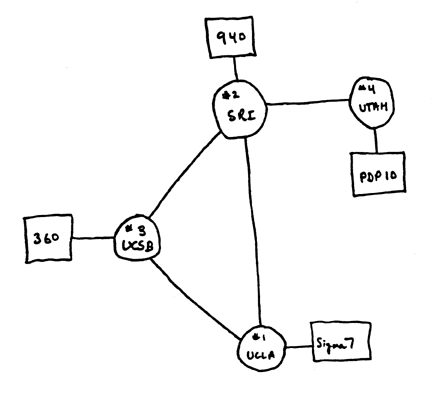You’re accessing archived content
This is archived content from the UIT website. Information may be outdated, and links may no longer function. Please contact stratcomm@it.utah.edu if you have any questions about archived content.
What's in a name?
In the case of Node 4, the U's role in the birth of the internet

Learn more from Marriott Library's ARPANET Project.
Since October 2013, Node 4 has been the University's source for UIT news.
Every so often, someone asks, “What does Node 4 mean?”
The short answer is: In 1969, the University of Utah’s Computer Science Department became the fourth node of ARPANET, the world's first packet-switching computer network and precursor of today’s internet.
Here's the long answer.
The internet can’t be traced back to any single inventor or birthplace, but an oft-quoted origin story involves the Cold War, Sputnik, fear of falling behind the Soviets, and tensions around a nuclear attack.
In 1957, news of humanity’s first artificial Earth satellite received a lackadaisical reception in the Soviet Union. Not so in the United States, where it shattered the popular belief that America was far-and-away the world’s leading technological superpower. For many Americans, Sputnik was stunning proof that the U.S. was lagging behind in the “Space Race.”
A significant science and engineering gap has since been discounted as hype, but competition begets innovation, and in 1958, the U.S. federal government founded the National Aeronautics and Space Administration (NASA) and the Department of Defense’s Advanced Research Projects Agency (ARPA), organizations tasked with developing space-age technologies, e.g., rockets, weapons and computers. ARPA later gained a "D," becoming the Defense Advanced Research Projects Agency (DARPA).
According to The History Channel, after Sputnik, scientists and military experts were especially worried about an attack on the nation’s telephone system, which made long-distance communication possible:
In 1962, a scientist from M.I.T. and ARPA named J.C.R. Licklider proposed a solution to this problem: a “galactic network” of computers that could talk to one another. Such a network would enable government leaders to communicate even if the Soviets destroyed the telephone system.
In 1965, another M.I.T. scientist developed a way of sending information from one computer to another that he called “packet switching.” Packet switching breaks data down into blocks, or packets, before sending it to its destination. That way, each packet can take its own route from place to place. Without packet switching, [ARPANET] … would have been just as vulnerable to enemy attacks as the phone system.

1969 ARPANET diagram from logs at UCLA (Computer History Museum)
In 1969, the University of Utah became the fourth node on the ARPANET – the first outside of California to join the network (after UCLA, Stanford Research Institute and the University of California Santa Barbara), an effort spearheaded by Computer Science Professor Ivan Sutherland, Ph.D., an A.M. Turing Award-winner.
Later that year, the first “node-to-node” message between research labs at UCLA and Stanford was delivered. “LOGIN” – albeit short and simple – crashed the network after the Stanford computer only received the "L" and "O."
The political backdrop of the internet’s early development may have been the Cold War, but the social force behind these technologies was undeniably in academia.
"We have found that, in the process of connecting machines and operating systems together, a great deal of rapport has been established between personnel at the various network node sites. The resulting mixture of ideas, discussions, disagreements, and resolutions has been highly refreshing and beneficial to all involved, and we regard the human interaction as a valuable by-product of the main effect."
- Stephen Carr, Stephen Crocker and Vinton Cerf, Feb. 1970
For a more detailed lifecycle of ARPANET, check out Marriott Library’s ARPANET Timeline Project (1969-1980).
Here, former School of Computing Professor Lee Hollaar, Ph.D., talks about what it was like when the U was a node on the ARPANET.
There you have it: The story behind the name Node 4, and the U's distinguished place in the history of the internet.
Node 4
Our monthly newsletter includes news from UIT and other campus/ University of Utah Health IT organizations, features about UIT employees, IT governance news, and various announcements and updates.
